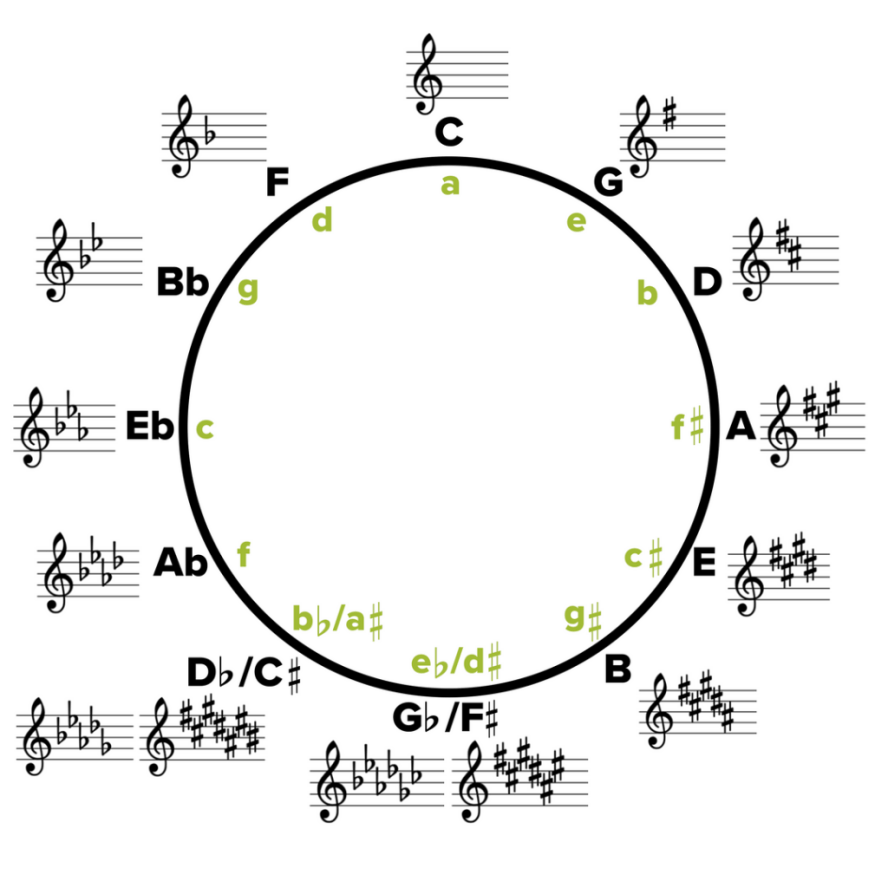
For those, who either approach harmonica for the first time or hear about playing in first, second or third position, getting perplexed isn't an uncommon occurrence. What does playing in the first position mean at all? Read this article and by the end of it, you will know exactly how to play the 'straight harp'.
Let's have a look at the circle of the fifths: the first position is the same, occupied by the key of the song on which we want to play, for instance, if the song is in C and we are using a C harp, then we'll play in the first position. The same goes for the example if we take an A tune and use an A harmonica.

After selecting both; i.e. harmonica and the position in which to play, the next step is to explore the instrument to understand which notes it makes available - useful for playing in the chosen tonality - which ones are absent and which notes must be avoided because they are not part of the key in question. To conduct this analysis, we have to keep in mind that the same position can be played in different musical contexts; e.g. the song can be major, minor, or blues. The evaluation of the notes present on the harmonica must be done for all these three situations.
Another aspect worth reviewing is the type of performance we want to achieve, because the same position which can give us useful notes to perform melodies, might also obstruct playing chords.
Let's start exploring harmonica in the first position on a major song.
What characterizes a major song? A song has a major key when the interval called 'the third' is a major third. For example: in case of a C song, if we find the E note; then the mode of the song is major, otherwise if we find the E flat note; then the tune is in minor. To recognize these combinations is the most important quality we need to excel; i.e. to become proficient in skills required for playing in different positions.
You must be wondering: "and the blues mode?" This is not a true mode, basically it can be related to a minor one or a mix of major and minor, since it is just the minor third to characterize the blues, that's why named as 'blue note'.
We now return to the major tonality and harmonica in the first position; e.g. if the song is in C major, its musical scale will contain the following notes: C, D, E, F, G, A, B; as we have already noticed that the note E is natural because it is the major third of the scale. All the notes of this scale are present on the harmonica holes 4 to 10, wheras the notes F and A are missing in the holes l to 4; though we can obtain them with the bending technique. On holes 7 to 10 we have all the notes except B, which can also be executed with bending.
There is a hierarchy among the notes on this scale - and ther lies great advantage for musicians in it - because they will always remember which notes to use and what's the purpose of each note during its execution. Bear in mind that each note has a function not only in coherrence with the reference scale, but also in accordance with the chord presented by the harmonic progression of that piece. To put it another way, playing note C on a C major chord has a different function than playing the same note on a major F chord.
Let's make things simpler:
The most important note when playing in first position is the same one that gives the name to the key; in case of C major, it's the note C. The first thing to learn to play in first position is where is this note located on the harmonica, considering it as grade l and not as an absolute pitch, such reasoning works with all the keys. We'll always refer to the notes emitted by a C instrument to grab these concepts better; it will actually be the harmonica, transposing notes for us when we change key.
The note C, first degree, is located on holes l, 4, 7 and 10 blow. When you play these holes you will always be tuned to the song.
The second important note to play in the first position is E; the third degree, as we just concluded it already: this is the one that forms the song mode. Since we are on a major tune, the harmonica makes this note available on holes 2, 5, and 8 blow.
The third note of the value of the first position is G, the fifth degree, and we find it on holes 2 draw, 3 blow, 6 blow and 9 blow.
Why these notes are so important? Because they generate the major C chord, the most important chord of the C key. If you take notice of the notes layout on the harmonica, you will find out that blowing through any hole of the instrument produces notes belonging to that chord only, and that is why they always sound good. When you have finally validated where these three basic notes could to be found on a harmonica, you could play them alone by just starting or ending the musical licks on any of these notes.
We continue now with the other notes: the D note or second interval sounds good everywhere in the C major tune and we find it on the l, 4 and 8 hole draw. You can use this note as a passing note too.
The F note or fourth interval should be used as a passing note because it might sound a little bit 'off the theme' in some contexts; e.g. in the chord progression of the song. You can get this note on hole 2 with double draw bending and also on holes 5 and 9 draw.
The A note or sixth interval can be played at will and has no contraindications. You'll find it on hole 3 draw with double bending and on holes 6 and 10 draw.
The last note that we take into consideration is 'B'. This note is a special one and it's deemed more appropriate to be used as a passing note.
Below, you see a diagram where you will find basic notes and the passing notes both, for playing on a major song. It will make learning - to play in the first position on a harmonica - easier for you.

We now perform the same analysis for a minor tune:
There are several reference scales to consider when it comes to minor mode. For simplicity, we'll analyze one called 'Dorian'. This scale consists of these notes: C, D, Eb, F, G, A & Bb. On this scale, grade 3 becomes minor (Eb) too as well as grade 7 (Bb).
Let's discover on the harmonica where we can locate the important notes for this scale alongside grade l, 3 and 5.
The first degree is note C and we already know where to find it.
The minor third; an E flat isn't to be found there. We can play it only if we practise bending on hole 8. This revelation has already made us realize that in the first position, playing on a minor song isn't convenient. Of course, all notes can be played with the harmonica if a musician is capable to play overbend; although we will refer to the notes either already available on the instrument or those that can only be obtained with the bending technique.
In the last, we will now analyze harmonica notes for playing the blues in first position. The C blues scale consists of the following notes: C, Eb, F, F#, G & Bb.
The first note; i.e. C, we know already where to locate her.
The minor third; i.e. an E flat, we only have it as a bend note of the hole 8, so if we want to play a full blues scale we have to use the holes from 7 to 10.
The F and F# notes should be played as passing notes.
The note G - the fifth degree of the scale - we know where to find it whereas the seventh minor is B flat.
We can play 'Bb' on either hole 3 draw with bending of one half-tone or on hole 10 blow with bending of whole tone.
The use of B flat should be clear: when the blues progression comes on the fifth degree chord (in case of a C blues: G7 chord) we can play natural B note since it is the third degree of the chord in question. The natural B note, however, should not be played on the rest of the blues progression in first position.
Have a look at the specific course to learn 1st position and improvisation, click on the image below.
For this position, we can also make use of the notes of the C pentatonic scale which are C, D, E, G and A. The D and A notes are played as passing notes.
You must have noticed that now l'm talking about the note E natural: the blues in particular because it allows the coexistence of both major and minor thirds which is not possible otherwise in major and minor tunes, where it is the third actually that determines the mode.
Be mindful as the natural E note must not be played when the blues chord progression moves onto the fourth chord, in case of a C blues, its the F7 chord that matters. The seventh minor of F is, in fact, the flat E which does not sound good together with the natural E.
Let's review how first position can be used:
First position harmonica on major tunes: Strongly recommended.
First position harmonica on minor tunes: Not suggested.
First position harmonica on blues tunes: Useful only if you have good bending skills and are adept at playing on high holes.
I conclude this article by inviting you to explore other positions which you have come to know today; understanding where to find notes on the harmonica is the best way to learn. See you soon!
If you want to comment this lesson use the contact form available here.
Marta Brehme
I play first position folk songs not much blues. I find this position fits really well wherever you need to play a complete major scale in the key of the tune, like a C major scale on a C song. Great explanations.
Paul Burton Lorenz
I try to play the blues in first position, but I can't hit overblows so I find myself just limited in the few notes available on the harp. Now I understand why second position is more common for this genre. Great lesson.
Bill Parton
Great position playing lesson, clear and complete. Thank you for sharing!